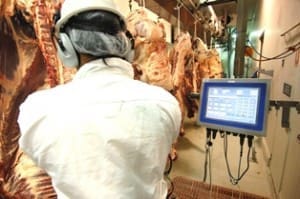RATES of slaughter dropped ten percent across eastern Australia last week, as processors put the cue back in the rack to try to weather the current cattle price storm by reducing throughput.
The size of the reduction in processing activity was extraordinary, for a week that was impacted neither by public holidays, nor wet weather.
 It signals that beef processors are now taking a more defensive position, electing to wind-back kills, rather than relentlessly chasing increasingly expensive slaughter cattle at a time when numbers on offer are rapidly tightening, and international meat markets are looking flat, at best.
It signals that beef processors are now taking a more defensive position, electing to wind-back kills, rather than relentlessly chasing increasingly expensive slaughter cattle at a time when numbers on offer are rapidly tightening, and international meat markets are looking flat, at best.
Last week’s five state kill totalled just 119, 611 adult cattle, with all states recording big reductions. Queensland was back a massive 16pc on the week before to just 53,025 head, and NSW down 9pc to 32,141 head.
Large numbers of export processing sheds from Queensland to Victoria are scheduling dark days again this week, in an effort to better align available supply and demand. Some plants will kill as few as three days this week, Beef Central was told.
Some operators say it is increasingly hard to forecast activity for the week ahead, given the difficulty in supply.
“It’s a moving target, because it’s impossible to predict numbers at present, either direct consignment or saleyards, despite the high prices on offer. We’ve come off really big saleyards offerings a month ago – we were taking 2000-3000 a week from the saleyards system – but now we’re nowhere near that. The numbers just aren’t there, either phone bookings, or the saleyards channel.”
Lag factor ahead in cows, particularly
The next month was likely to be ‘particularly tough’ for slaughter cattle supply, one large operator said.
That’s because any producers fortunate enough to get some decent January/February rain are now holding those cattle back, wanting to add weight before they come to market.
A theory is emerging that cows will virtually disappear for a period.
The last three or four months has seen a lot of slaughter cows being killed, having been grain-fed in feed yards to add some condition. One southern Queensland processor spoken to for this week’s report said his plant had recently been killing about 1000 such fed cows a week. Some of those were bought as store cull cows by traders, to place onto feed.
Some yardings in centres like Dalby have seen at least half (one processor buyer’s estimate) of the weekly yardings comprised of stock that had has some form of grain feeding program. But that has now abruptly stopped.
“Cows have been a major part of that, but there’s also a lot of yearling type cattle 400-500kg that have come through a similar background,” he said.
Given the short feeding time involved, those fed cows would run out in the next couple of weeks, the processor said, and there would inevitably be a ‘void’ of at least a couple of months before any significant numbers of grass-finished cull cows, exposed to the new body of feed that has emerged, would hit the market across eastern Australia.
“I’ve heard reports of vendors changing direction – pulling cows out of custom feedlots after a month’s feeding, because they suddenly have a big body of feed in paddocks at home,” he said.
“But it will take at least two months to put condition on a grass cow to bring her to slaughter condition, so we’re not expecting to see cow numbers – or grass steers for that matter – start to grow until at least late April or early May,” he said.
Any rise in good grass-finished cattle from May/June was not likely to last long however. “We don’t think any flush of cattle will be sustained this year,” a processor said.
Qld grids unchanged
Queensland direct consignment price grids are unchanged this week, maintaining record price levels set three weeks ago.
In southern Queensland, grassfed four-tooth steer prices this week remain at 600-640c/kg on competitive grids, depending on location – well above the previous record highs seen briefly last year.
Good heavy cows remain in the 530-550c/kg range in most southern Queensland grids this week, with one operator continuing to offer an unprecedented 580c/kg for cows from MSA-eligible herds.
Over the hooks rates in NSW last week saw a 10c/kg rise in grown four-tooth steer offers, on average, to around 577c, while cows also lifted 10c/kg to 515c for cows 280kg+.
In Victoria, heavy cows lifted 5c/kg last week in over the hooks offers to 506c, while grown steers lost 5c to 583c.



HAVE YOUR SAY